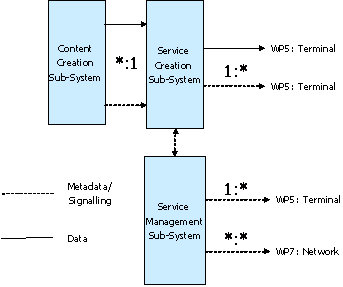|
|
Work Package 3
Content, Services and
Applications
The aim of this workpackage
is to develop a semi-automated content/service design flow where:
-
Content is packaged
independently from the target terminal and associated delivery network,
-
Network-independent
service components assembles previously produced multimedia content
into a coherent service and generates the associated terminal user
interfaces and applications to access them,
-
Services are specifically
adapted to the targeted delivery networks,
-
Applications and user
interfaces to be run on target devices are semi-automatically generated
in order to accelerate the application design process.
The aim of this workpackage is to develop a generic service management
platform where:
-
Service Level Agreement
(SLA) framework is established between the Service Manager, Service
Creators, End-Users of terminals and Network providers.
-
Service Management
system provides a service scheduling system that announces and activates
services and sessions in a manner that is applicable to cellular,
broadcast and independent centred service provider environments.
-
The Services Manager
manages the integrated SLA framework by monitoring service level
provided by the Network providers and cross checking this with end-to-end
service level monitoring with the user terminal. Long term records
are kept to establish service level trend of extended period of
time (weeks/months/years).
-
Personalised service
manager provides a list of services that is available to end users
based on their stated user preferences and any terminal type that
the end-user happens to be using.
-
User Manager administers
the day-to-day transactions with the end user such as Contract Management,
Subscription Management, Authentication/Authorisation and Billing.
This workpackage is motivated
by the business need to increase content/service creation productivity
while addressing the increasingly diverse means of accessing services,
in terms of networks and terminals. This productivity is enhanced by
making common as many steps as possible in the content/service creation
and management process. Service management system architecture needs
to be generic enough to be applicable to cellular centred (Orange),
broadcast centred (BBC) and independent (Virgin) service provider business
models. Modular network and platform level descriptions needs to be
combined into a range of service agreements that can be used to draft
service contracts with individual and groups of users within a billing
model and subscriber management system. The following content, service,
application and management activities related requirements have been
identified as:
-
At the content creation
level a set of tools is required to create media for services using
agreed base formats such as: MPEG-2 and MPEG4 for audio-visual and
3D graphics, XML and XSLT for Internet content and MPEG-7 for media
metadata.
-
At a network-independent
level of service creation, a set of tools is required to describe
service components such as conditional access, generic return channel
requirements, account monitoring, security and privacy of content.
-
At the network-dependent
service creation, a set of tools is required that make the final
service and content adjustments, specific to the (combination of)
networks that are finally used. MPEG-21 for service metadata and
TVAnytime for program service metadata will be used for enable smart
content manipulation at various stages of the creation process,
and at the terminal side.
-
At the terminal-dependent
service creation level, a set of tools is required to describe how,
where and when to transcode base formats into formats that can be
consumed by the various terminals.
-
At the service management
level, a set of tools is required to establish and monitor service
level agreements, announce and activate services, administer day-to-day
transactions with end users and provide a personalised service based
on preferences and type of terminal.
The workpackage 3 Content,
Services and Applications sub-system architecture is shown in Figure
1 where *:1 denotes a many-to-one, 1:* denotes a one-to-many and *:*
denotes many-to-many relationships.

Figure 1: Sub-System architecture
At all times consultation
with the content creator teams that produce, generate and edit (metadata)
of content and content will be considered. Crucial elements that have
been identified are:
-
Central server architecture
connected to a Service Creation System allowing for quick, cost
efficient and automated content editing.
-
Both re-purposing
of existing broadcasting and web content for new/additional delivery
channels and content creation designed "from the scratch"
for multiple playout.
-
New workflows must
be tested and documented, and examined by a central production department
for a number of different platforms to determine what would really
make sense and the implications to the future structure of public
broadcasting environments.
The main innovations of
this workpackage will consist of:
- A scalable service creation system
that builds and uses scaled service descriptions to process and
to conditionally deliver scaled user interfaces, scaled applications
and transcoded media based on service agreement, subscriber and
billing management system. It shall rely on Scaled service description
tools and media transcoding tools.
- Digital rights management tools
to potentially enforce conditional service access.
- Service agreements, subscriber
management and billing management description tools.
- Automated user interface and application
generation tools.
|